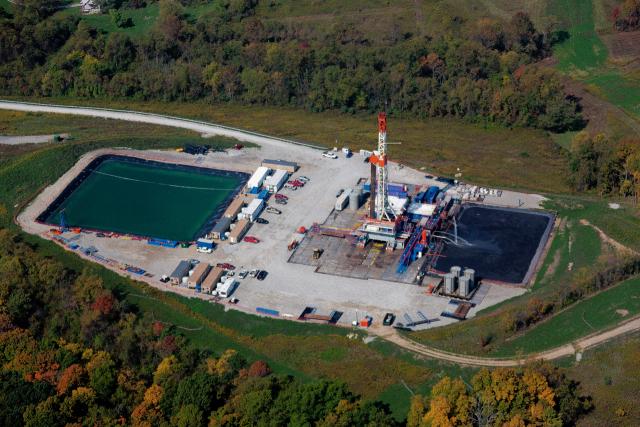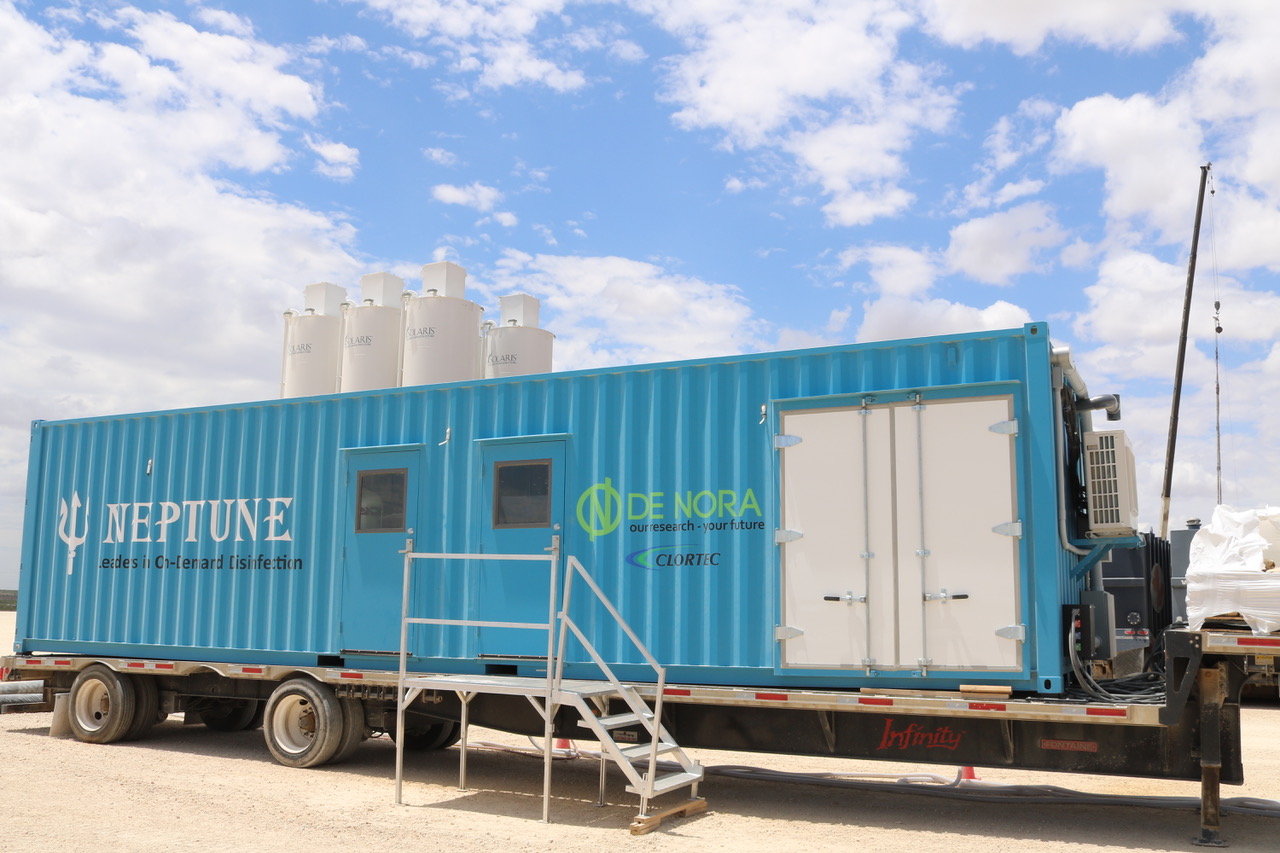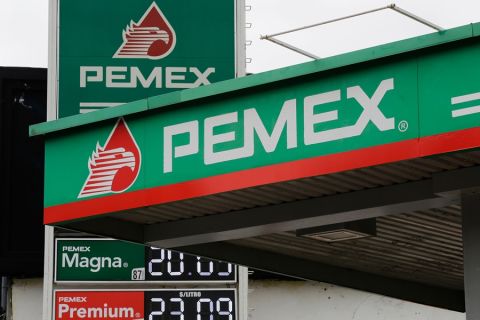
A drilling rig in the Marcellus Shale is surrounded by the water management infrastructure that is essential to drilling and completion activities. (Source: De Nora Water Technologies)
The Permian Basin’s water balance is dominated by one inescapable feature: its wells produce three to five times more water than is required for completion activities across the play. In 2019, 4.1 Bbbl of water will be produced, but the demand for completion fluids is only estimated to be 1.2 Bbbl. Even if every drop of produced water in the Permian Basin was recycled and used in completion activities, there would still be 2.9 Bbbl per year that required disposal or discharge at economics that only support the former, not the latter.
Those same wells also produce that water at an inconvenient pace. Any given Permian Basin well will only produce 30% (in the Midland Basin) to 75% (in the Delaware Basin) of the water required to complete an identical well in the first 12 months of its life. The balance comes over the next 20 years. Any wells drilled near their predecessors will not be able to rely on recycled produced water alone for their completion, and infill water will always be required in a very water-scarce area with an aquifer under extreme pressure.
It is a strange situation of short-term scarcity and long-term abundance that leaves Permian Basin operators scrambling for water where they need it and drowning in water where they do not. This all serves to feed the myriad disposal wells in the region, which dispose of more than 2.5 Bbbl of water per year. Although critical to mitigating some of the impact, recycling on its own will never be enough due to this water balance. Treatment to discharge will ultimately be the only solution to the water situation in the Permian Basin.
Marcellus: a study in contrasts
While Marcellus operators face similar challenges in needing to supplement their treated produced water with freshwater (on average only 10% of new completion water requirements are met by produced water), by contrast the Appalachian Basin has an abundance of freshwater fed rivers, significant rainfall and productive aquifers. The sourcing and use of this water for well completion activities, although tightly regulated by the department of environmental protection (DEP) in the various states and not without cost and environmental implications, are comparatively easy.
Marcellus wells, being predominantly gas wells, are significantly less productive in terms of produced water than their Permian cousins. The fundamental water balance of the play is different; more than 95% of the wells producing the wastewater are horizontal wells rather than vertical— and those wells require significant volumes of water to complete. Looking at permitting, this appears likely to continue. Of the 723 permits for unconventional oil, gas and combined oil and gas wells by the Pennsylvania DEP in 2019 so far, only one was for a vertical well. These permits represent ample completion activity to consume the produced water being generated by the wells.
Each Marcellus well on average will produce approximately 40,000 bbl to 100,000 bbl of produced water over its working life, with some regional variation. That still adds up to a lot of brine. Ohio horizontal wells produced 7.6 MMbbl of produced water in the first quarter of the year per the state’s DEP—a mere 0.0125 bbl/ Mcf of natural gas on average—but equating to 84,000 bbl/d of produced water that requires a home.
In the same period, Pennsylvania operators managed, disposed or centrally treated 13.7 MMbbl of produced water from unconventional wells per the DEP. Of that, 12.3 MMbbl were handled within Pennsylvania. Of that water, 64% was reused at the well pad through blending with freshwater for completion activities following ad hoc recycling, 26.9% was sent to residual waste processing facilities and 7.91% found its way into local impoundments at the surface. Only 0.77% of the water found its way to disposal wells within Pennsylvania. Of the 1.5 MMbbl of produced water that left the state, 1.1 MMbbl of it was sent to disposal wells in Ohio, which is a mere 12,200 bbl/d on average.

Challenges
This situation is not without its potential risks, however. The Marcellus Shale has been a comparatively stable operating basin in terms of completion activities, despite the lower for longer pricing of natural gas. That said, with 64% of the produced water in Pennsylvania currently dependent on reuse in completion applications as an effective disposal strategy, a significant slow-down in completion activities would result in a glut of produced water that is beyond the current rated/permitted capacity of the central facilities that treat the bulk of the water not reused on the pad. This would equate to a lot of water traveling at a high cost to Ohio to be disposed of in injection wells.
The other feature of Marcellus produced water, which exacerbates the situation above, is that it is extremely salty and becomes saltier as the age of the well increases. The levels of total dissolved solids upward of 90,000 ppm are not uncommon, often rising to 120,000 ppm within two years. Of that, 30 ppm to 50 ppm can be barium or other naturally occurring radioactive materials carrying salts. Barium, if not removed from the water, can scale infrastructure, gradually resulting in environmentally problematic concentrations and special disposal requirements.
While not intrinsically an issue on its own (the infrastructure certainly isn’t glowing green), when disposing of that infrastructure, it is not uncommon to find that the entire installation has become “hot,” requiring disposal as hazardous waste. A bucket of sludge from recycling operations in the Marcellus Shale can, through the presence of this one dirty penny, become hazardous and by definition increase solids disposal costs by order of magnitude. While most operators are not overly concerned by this, others are taking it seriously and requiring very low barium levels for reuse of the water to protect their infrastructure.
Water transportation costs are high in the Permian Basin but an order of magnitude higher in the Marcellus Shale due to a combination of permitting requirements, road infrastructure and geography. Well pad conditions are tight, roads often traverse mountains and moving water around by lay-flat hose as is routinely conducted in the Permian Basin is rarely, if ever, an option for regulatory reasons. For this reason, recycling locations near peak drilling areas that can meet the requirements for additional recycling are beginning to rise to prominence. For example, Kendra II LLC, a relative newcomer to the space, has announced it will commence operations in the third quarter of this year—in the heart of drilling acreage operated by Cabot Oil & Gas.
It is not alone; multiple other facilities are either in planning or development to service specific geographic niches with both water treatment for reuse and transportation. While the per barrel cost of these operations in the Marcellus Shale is higher compared to the alternative (a costly truck ride to Ohio), it seems probable that the number of processing facilities in this basin will increase as more and more operators see a strong attraction to the stable environment.
The operators in the Marcellus were trailblazers in handling produced water, rapidly moving to as close to 100% reuse as was required, and the trend seems set to continue, particularly as ample companies in the market have an appetite for running central treatment facilities.
Recommended Reading
EU Expected to Sue Germany Over Gas Tariff, Sources Say
2024-04-17 - The German tariff is a legacy of the European energy crisis that peaked in 2022 after Moscow slashed gas flows to Europe and an undersea explosion shut down the Nord Stream pipeline.
Pemex to Remain Fiscally Challenged for Mexico’s Next President
2024-04-16 - S&P Global Ratings said Pemex will remain a fiscal challenge for the country’s next president, adding that continued cautious macroeconomic management was key in its ratings on both Mexico and Pemex.
Yellen Expects Further Sanctions on Iran, Oil Exports Possible Target
2024-04-16 - U.S. Treasury Secretary Janet Yellen intends to hit Iran with new sanctions in coming days due to its unprecedented attack on Israel.

